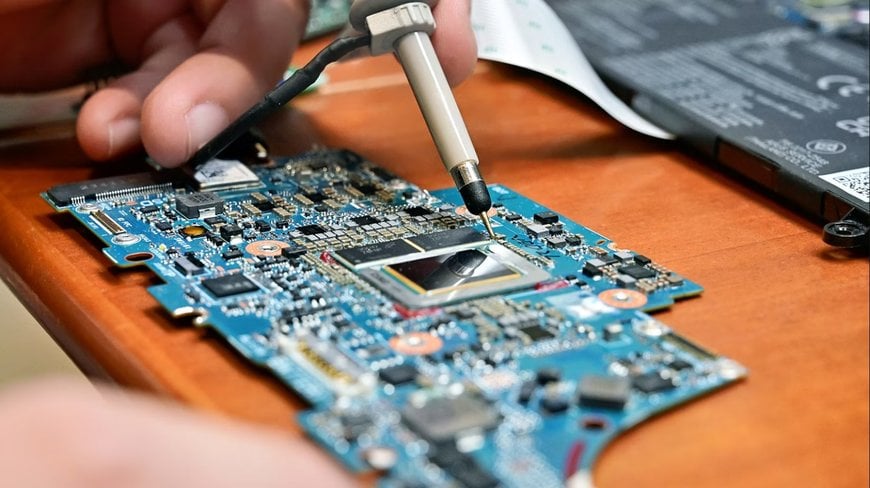electronics-journal.com
17
'24
Written on Modified on
How Intel Helps Deliver World-class AI PCs to Top PC Makers
Intel engineers join OEMs in the lab to take on unexpected challenges as a new chip architecture comes to life.
www.intel.com

Launched in September, Intel® Core™ Ultra 200V Series Processors – code-named Lunar Lake – deliver breakthrough performance and efficiency for the AI PC. An important Intel first helps make that efficiency possible: it includes memory modules on the same package as compute tiles.
This change reduces both the chip’s circuitry board footprint – freeing up precious space that enables modern thin-and-light laptop designs – and the power consumption of moving data through the system, by approximately 40%.
But the path to launching an all-new chip isn’t easy – especially when considering the demands included with more than 80 Lunar Lake-based laptop designs from 20-plus manufacturers coming to market.

All-new architecture introduces new issues that need quick resolution
When Intel’s top customers – PC OEMs rolling out new Lunar Lake laptops – began testing early Lunar Lake designs in their laptop prototypes, they were surprised by issues they’d never seen before.
One particular issue proved vexing: noise from the system.
In late April, ASUS discovered its early Lunar Lake designs generated an annoying hum when testing the system across different workloads and configurations. Measuring at a peak of about 28 decibels above ambient lab noise – about as loud as a whisper in a quiet room – it might not seem like a big issue, but it threatened ASUS’s ability to deliver laptops with best-in-class user experience.
They turned to Intel engineers for help.

Intel’s worldwide engineers partner to find and fix top issues
A joint Intel task force comprising hardware and software engineers, along with other experts from immediately began investigating the issue alongside their OEM partners.
- A hardware-focused task force reviewed ASUS’s initial board design and provided guidance on layout, bill of material selection and placement recommendations. The hardware mitigation effort reduced the noise by 20 percent.
- On the software side, experts optimized Lunar Lake’s P-cores, E-cores and power management policies to reduce overall noise levels without compromising battery life or performance. The software mitigation also developed new algorithms that reduced the noise of the ASUS design by an additional 30 percent.
- Intel’s acoustic noise lab in Taiwan – equipped with an industry-standard acoustic chamber and dedicated measurement equipment – allowed the team to accurately chart noise levels in real time across workload simulations and then test different hardware and software configurations.
All that hard work paid off.
After nine short weeks, the team successfully reduced noise ASUS’s platform threshold requirements without compromising their schedule.
Providing deep co-engineering expertise to help resolve thorny technical problems is one of many high-touch services Intel offers to partners across the globe, explains Jeffery Tang, CCG Taiwan Site Leader, Executive Director, CCG, PEG.
Intel engineers uncovered and squashed bugs so early in the laptop design process that PC OEMs reported a staggering 96% drop in critical issues across subsequent laptop designs.

Intel-led innovations help cut costs without impacting quality or performance
Joint teams also delivered other industry-first innovations on the Lunar Lake platform.
One Intel team co-engineered an all-new printed circuit board (PCB) design with ASUS – it’s the most compact PCB Intel has ever enabled on a modern thin-and-light PC platform. This helped ASUS deliver the necessary power to its Lunar Lake designs without generating excessive heat.
Intel and ASUS also partnered on multiple power management and conservation features that enabled ASUS’s Lunar Lake designs to extend battery life. For example, the joint team optimized the laptop display’s OLED screen by dynamically and adaptively contrast and brightness of content while bringing down luminance to save power.
Another software-driven innovation in integrated graphics led to ASUS’s Lunar Lake designs during extended gameplay sessions.
Intel Inside: Lunar Lake powers 4 different ASUS AI PCs
At IFA Berlin in September, ASUS revealed those new systems, including the Zenbook S14 that early tech reviewers have put to the test.
The verdict? “ASUS has built a terrific laptop … a super sleek, thin, and premium feeling laptop that leaves very little to be desired across the board,” writes XDA-Developers.
www.intel.com
After nine short weeks, the team successfully reduced noise ASUS’s platform threshold requirements without compromising their schedule.
Providing deep co-engineering expertise to help resolve thorny technical problems is one of many high-touch services Intel offers to partners across the globe, explains Jeffery Tang, CCG Taiwan Site Leader, Executive Director, CCG, PEG.
Intel engineers uncovered and squashed bugs so early in the laptop design process that PC OEMs reported a staggering 96% drop in critical issues across subsequent laptop designs.

Intel-led innovations help cut costs without impacting quality or performance
Joint teams also delivered other industry-first innovations on the Lunar Lake platform.
One Intel team co-engineered an all-new printed circuit board (PCB) design with ASUS – it’s the most compact PCB Intel has ever enabled on a modern thin-and-light PC platform. This helped ASUS deliver the necessary power to its Lunar Lake designs without generating excessive heat.
Intel and ASUS also partnered on multiple power management and conservation features that enabled ASUS’s Lunar Lake designs to extend battery life. For example, the joint team optimized the laptop display’s OLED screen by dynamically and adaptively contrast and brightness of content while bringing down luminance to save power.
Another software-driven innovation in integrated graphics led to ASUS’s Lunar Lake designs during extended gameplay sessions.
Intel Inside: Lunar Lake powers 4 different ASUS AI PCs
At IFA Berlin in September, ASUS revealed those new systems, including the Zenbook S14 that early tech reviewers have put to the test.
The verdict? “ASUS has built a terrific laptop … a super sleek, thin, and premium feeling laptop that leaves very little to be desired across the board,” writes XDA-Developers.
www.intel.com

